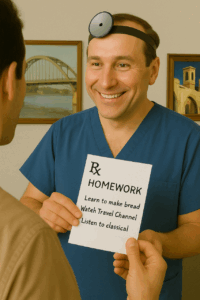By Ali Ahmadizadeh, MD
I still remember the joy of receiving my first prescription pad after graduation in 1987. The pride was immense. Holding that pad in my hand was more than just a symbol of clinical authority—it felt sacred. Each page was a vessel for my commitment to healing, signed not just with ink, but with intention.
We were taught that the symbol “Rx” represents an invocation of divine healing, derived from the Latin word recipe, meaning to take, but often interpreted as a prayer to Jupiter, the Roman god of healing. In that way, every prescription bore a spiritual weight. And your handwriting was the seal of your conscience.
Back then, you could almost read the prescriber’s mood from the style of their script. A hurried scrawl, a thoughtful loop, a firm underline—each told a story. For patients, it made the visit personal. They left not just with medicine, but with something crafted for them. A unique piece of paper that reflected the attention, presence, and care of their physician.
Then came the electronic medical record (EMR). The adoption was swift and widely embraced, for good reason. EMRs improved access, documentation, coordination, and billing. From a systems perspective, the benefits are undeniable.
But something was lost—something harder to measure but deeply felt.
In the transition to digital, the human touch of a handwritten note quietly disappeared. Most visits now end with a paperless send-off: a click, not a connection. While we’ve gained efficiency, we’ve lost a tangible part of the physician-patient bond.
Over the years, I’ve found myself returning to my old prescription note pad—not for medications, but for something more human. At the end of a meaningful visit, I write my patient a brief, personalized note. At the top, I title it: Homework.
 These aren’t medical directives in the traditional sense. They’re small acts of care that speak to the soul:
These aren’t medical directives in the traditional sense. They’re small acts of care that speak to the soul:
— Learn to make bread.
— Watch the Travel Channel.
— Listen to classical music.
— Avoid the news for a week, to name a few.
They’re based on the encounter—sometimes playful, sometimes reflective—but always personal. And almost all my pediatric patients from age three to 10 leave with a wooden tongue depressor that I open and draw a happy face for them once they answer a math question.
And the response? Gratitude! Smiles! A moment of connection that lingers beyond the exam room.
Dear Dr. Ahmadizadeh,
Read your article, first of all many thanks for sharing .
How true you mentioned about a touch of trust , personal , and feelings you give your patients in what you briefly explained.
Since I have known your Father Dr. M. Ahmadizadeh Senior, who is also an ENT , he used to write a very brief history of patient in the back of prescription , with such a very fine writing , and insisted to bring along the prescription on next visit.
I really prefer this rather to this (EMR).
Bless you, your family and us all…
Kind Regards,
Mehdi Sajjadi